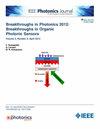RS Coded Mixed RF and Multi-Hop FSO System for 5G-CRAN- A Performance Analysis
IF 2.4
4区 工程技术
Q3 ENGINEERING, ELECTRICAL & ELECTRONIC
引用次数: 0
Abstract
Intensity modulation/direct detection (IM/DD) multi-hop Free Space Optical link system and mixed single-hop RF link performance in serial relaying are examined for the 5G centralized radio access network (C-RAN). While the FSO link utilises a Gamma-Gamma (G-G) distribution channel, the RF link employs a Generalised Nakagami-m fading channel. For the serial relaying method, RF employs the M-ary Quadrature Amplitude Modulation (M-QAM) modulation scheme, whereas FSO uses the Binary Pulse Position Modulation (BPPM) scheme. The decode and forward technique is used in relays. The proposed system’s performance is estimated regarding Average Symbol Error Rate (ASER), Ergodic Channel Capacity, and Outage Probability. The proposed system leverages Reed Solomon’s coding techniques to enhance its performance. The effectiveness of the system is assessed by comparing coded and uncoded systems under various atmospheric weather conditions, including atmospheric turbulence (AT) and pointing error (PE). Monte Carlo simulation validates the results, demonstrating how the system can support 5G applications.5G-CRAN- A的RS编码混合射频多跳FSO系统性能分析
研究了5G集中式无线接入网(C-RAN)中强度调制/直接检测(IM/DD)多跳自由空间光链路系统和串行中继中混合单跳射频链路的性能。当FSO链路使用伽马-伽马(G-G)分配信道时,RF链路使用广义Nakagami-m衰落信道。对于串行中继方法,RF采用M-ary正交调幅(M-QAM)调制方案,而FSO使用二进制脉冲位置调制(BPPM)方案。在继电器中使用解码和转发技术。该系统的性能是根据平均符号错误率(ASER)、遍历信道容量和中断概率来估计的。提出的系统利用里德·所罗门的编码技术来提高其性能。在各种大气天气条件下,包括大气湍流(AT)和指向误差(PE),通过比较编码系统和非编码系统来评估系统的有效性。蒙特卡罗仿真验证了结果,展示了系统如何支持5G应用。
本文章由计算机程序翻译,如有差异,请以英文原文为准。
求助全文
约1分钟内获得全文
求助全文
来源期刊

IEEE Photonics Journal
ENGINEERING, ELECTRICAL & ELECTRONIC-OPTICS
CiteScore
4.50
自引率
8.30%
发文量
489
审稿时长
1.4 months
期刊介绍:
Breakthroughs in the generation of light and in its control and utilization have given rise to the field of Photonics, a rapidly expanding area of science and technology with major technological and economic impact. Photonics integrates quantum electronics and optics to accelerate progress in the generation of novel photon sources and in their utilization in emerging applications at the micro and nano scales spanning from the far-infrared/THz to the x-ray region of the electromagnetic spectrum. IEEE Photonics Journal is an online-only journal dedicated to the rapid disclosure of top-quality peer-reviewed research at the forefront of all areas of photonics. Contributions addressing issues ranging from fundamental understanding to emerging technologies and applications are within the scope of the Journal. The Journal includes topics in: Photon sources from far infrared to X-rays, Photonics materials and engineered photonic structures, Integrated optics and optoelectronic, Ultrafast, attosecond, high field and short wavelength photonics, Biophotonics, including DNA photonics, Nanophotonics, Magnetophotonics, Fundamentals of light propagation and interaction; nonlinear effects, Optical data storage, Fiber optics and optical communications devices, systems, and technologies, Micro Opto Electro Mechanical Systems (MOEMS), Microwave photonics, Optical Sensors.
 求助内容:
求助内容: 应助结果提醒方式:
应助结果提醒方式:


